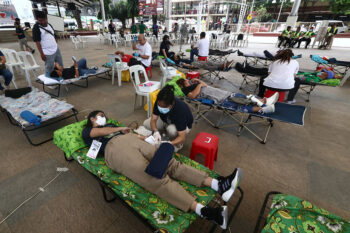MALAYBALAY CITY (MindaNews/10 September) – It was during Martial Law that the military started using subalterns in the campaign against the communist-led New People’s Army (NPA). In areas that were heavily influenced or infiltrated by rebel forces the military would train and arm these groups, and set them loose against the guerrillas and civilians suspected to be aiding the armed movement.
Those groups were not the Civilian Home Defense Force, the precursor of the Civilian Armed Force Geographical Unit; they were a mishmash of millenarian sects whose practices blend Catholicism with folk beliefs. There is good reason to believe they evolved from groups like the Colorum and Lapiang Malaya, which fought for freedom from colonialism and for peasant emancipation. As they were imbued however with high doses of anti-communism, the sects that emerged during Martial Law shed off [their] libertarian genes and mutated into petty tyrants.
These quasi-religious sects went by different names. One was called Sagrado Corazon Senor (Sacred Heart of Jesus), although their ways were anything but sacred. Said to have started in Initao town in Misamis Oriental, the Tadtad, as the group was called for their practice of mutilating their victims in what would appear to be ritual killings, announced their existence with the massacre of Renato Bucag, his wife Helen and son Renato Jr. in 1984. They all died with hack wounds. Bucag, a city councilor in Gingoog, belonged to a political party opposing the dictatorship.
A police official was implicated in the bloodbath. But instead of being prosecuted, a politician took him in as personal bodyguard.
In other provinces of Mindanao similar sects emerged in the fight against the NPA – Rock Christ, Ilaga (Rat), Rizalian, Bolo Battalion, to name some. The Ilaga, originally used against the Moro National Liberation Front, also took part in the anti-insurgency campaign. They had been accused of committing atrocities against civilians, but it was the murder of Italian missionary Fr. Tullio Favali in Tulunan, North Cotabato in 1985 that sparked international outrage leading to the prosecution and conviction of Ilaga leaders, among them Norberto, Edilberto and Elpidio Manero.
(The Manero brothers were convicted in 1987. Edilberto and Elpidio were released in 2003 and Norberto in 2008.)
Aside from killing Favali, witnesses said the brothers ate bits of the priest’s brains, an account that affirmed the penchant of their kind for macabre rituals they believe would give them power. Sources interviewed by this author in 1984 claimed that the Tadtad, for instance, held rites where members hit their bodies with machetes while mumbling foreign-sounding phrases. Before going to battle, the sources added, the Tadtad would drink a concoction and utter words believed to make them invincible.
After Marcos’ ouster in 1986, the military somehow discarded the use of fanatical sects. They turned to organizing and arming anti-communist vigilante groups like the Alsa Masa of Davao City and Nakasaka of Davao del Sur. The vigilantes, who did the dirty work like executing suspected rebels, gradually faded into oblivion particularly after the death of its foremost propagandist, broadcaster Jun Pala. The NPA disowned responsibility for Pala’s death.
In the countryside, however, the use of paramilitary groups with no formal ties to the Armed Forces of the Philippines continues to this day. Groups like the Alamara in North Cotabato and Bukidnon and the Magahat/Bagani in Surigao del Sur have time and again sown terror among rural communities. In Surigao del Sur, their latest victims were three Lumad leaders who were killed for alleged links to the armed movement.
Put on the defensive by the public uproar over these killings, the AFP has reportedly disowned the Bagani. Yet Surigao del Sur Governor Johnny Pimentel himself declared that the group “is a creation of the military”. He also blamed the same group for killing other people including barangay leaders. “They (military) created a monster they could no longer control,” he added.
On paper, it is easy for the military to disown the Bagani and other paramilitaries for that matter; unlike the Cafgu, these groups don’t officially function as part of the security sector. Yet the way they have been acting without impunity tells a different story. For one, who gave them those expensive high-powered firearms? Surely, it could not be the NPA. (MindaViews is the opinion section of MindaNews. H. Marcos C. Mordeno can be reached at hmcmordeno@gmail.com)







